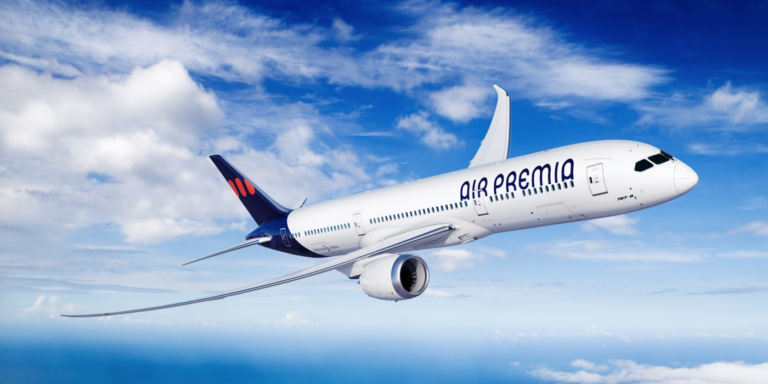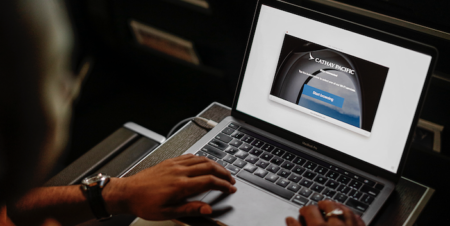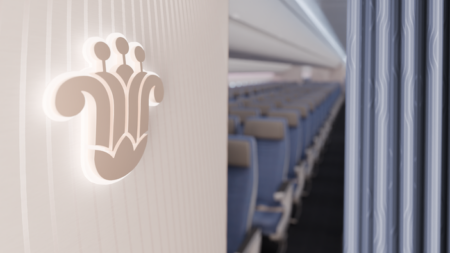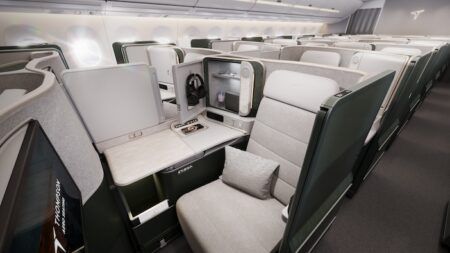Air Premia, a South Korean airline due to begin operations in 2020, has revealed the first details of the cabin hardware for its Boing 787-9 Dreamliner fleet. The airline is seeking to fill a perceived gap between South Korea’s full-service carriers (Korean Air and Asiana Airlines) and the region’s many low-cost carriers (LCCs) by offering a ‘hybrid carrier’ service that combines reasonable price and premium service, serving long and medium routes that LCCs cannot fly, at fares lower than full-service carriers can provide.
The airline is backed by airline executives, professional investors, venture capitalists, private equity funds, financial institutions, who predict that demand from South Koreans for long-haul travel combined with comfortable service will grow as the country’s GDP per capita exceeds US$30,000. With the latest figures estimating a US$32,000 GDP per capita, if their predictions are right then Air Premia could be a success.
Air Premia has a single aircraft strategy to simplify operations, and plans to introduce three B787-9s in its first year of operation (first delivery in July 2020, followed by the second aircraft in September, and the third in November), and to add up two jets every following year, for a planned total of 10 aircraft in five years. The schedule for any further aircraft deliveries is to be confirmed in the second quarter of 2019.
The 309-seat Dreamliners will offer two classes: a 56-seat premium economy class with a 42in seat pitch and services such as priority check-in, boarding and baggage handling; and a 253-seat economy class with a 35in seat pitch and what the airline claims will be “the widest economy seats in the class”. The ticket price for economy class is planned to be set at 80-90% of that offered by South Korean full-service carriers (FSCs), and premium economy fares at 140% of South Korean FSCs.
This will be the first premium economy class to be fitted by a South Korean carrier. Asiana’s ‘Economy Smartium’ class is an extended legroom economy (an extra 3-4in for a total of 36in), while Korean Air’s three-class aircraft only have a standard economy cabin, albeit with a generous 34in pitch on its B787-9s.
The airline has not revealed its cabin designs yet, but has announced that it has selected Recaro Aircraft Seating to equip its fleet, with the PL3530 model to be fitted in premium economy class, and the CL3710 in economy class.

The PL3530 has been specifically designed as a premium economy class seat, with an ergonomic design, numerous configuration possibilities, and comfort features including an individually adjustable calf rest, a foot bar, as well as stowage and privacy features. The seat is offered with a wide range of customization options that will enable Air Premia to make the design its own.
The lightweight CL3710 model in economy class has been designed to minimize weight while maintaining a good level of comfort, and again its modular construction enables a wide range of customization options. The specific options selected, and the overall cabin schemes will be revealed closer to the airline’s inaugural flight in September 2020.
Dr Jong Chul Kim, CEO of Air Premia stated, “As a hybrid airline we promise our passengers a combination of comfort and quality at a reasonable price. This ensures our passengers the best travel experience, but also helps us to be as cost-efficient as possible by reducing fuel burn and hence costs.”
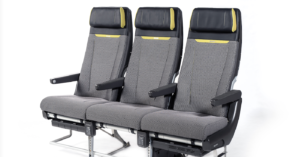
Most of Air Premia’s target routes will be strategically comprised of flights longer than six hours, between Seoul and North America, Europe and Oceania. Long-haul service will begin from 2021, with destinations including Los Angeles and San Jose and plans to add Honolulu, Vancouver, Munich (or Berlin), and Cairns.


